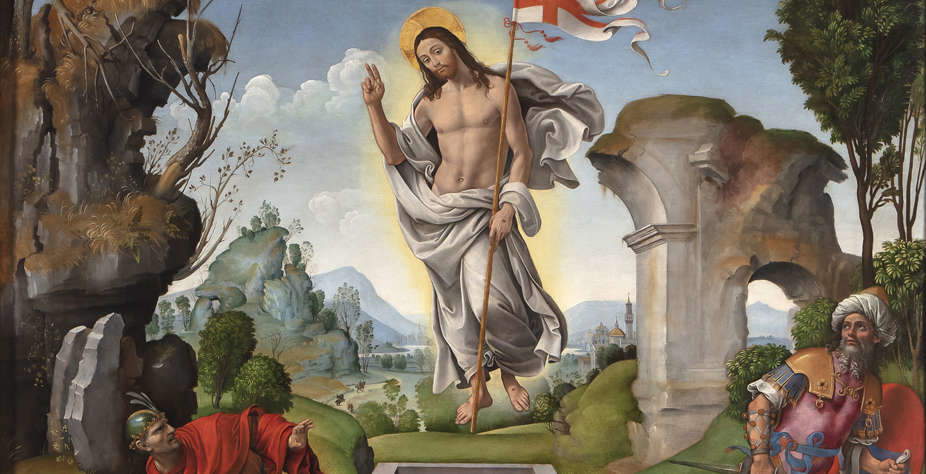Florence, a documentary for the restoration of Raffaellino del Garbo's Resurrection
The Galleria dell ’Accademia in Florence presents a video-documentary, produced to tell the story of the restoration of the panel painting depicting The Resurrection by Raffaellino dei Carli, known as del Garbo (S. Lorenzo a Vigliano, 1466 - Florence, c. 1525), from the early 16th century, and about its monumental wooden frame. Through the interventions of Cecilie Hollberg, director of the Galleria dell’Accademia in Florence, Cesare Sampieri, art historian, and restorers Debora Minotti, for the pictorial part, Roberto Buda, for the wooden support, and Luisa Landi, for the frame, the video, produced by Art Meet, directed by Sandro Nardoni, illustrates the various stages of the interventions carried out on the work as a whole and also delves into the figure of its author, Raffaellino dei Carli, known as del Garbo, precisely because he had a workshop in the street of the same name in Florence.
The altarpiece was commissioned by the Capponi family for the chapel known as the Chapel of Paradise in the church of S. Bartolomeo in Monteoliveto. It was executed between 1500 and 1505, and the frame, a few years later, bears the family coat of arms. It is one of the first public panels with which Raphael shows himself, after his stay in Rome following his master Filippino Lippi, as Vasari also writes in Lives. Within the traditional iconography of The Resurrection, the research in the human characterization of the characters is striking. In the features we find both the influence of Filippino Lippi and that of Verrocchio and Leonardo, whose La Battaglia di Anghiari he is presumed to have seen. Moreover, the setting of the scene recalls the compositions of Domenico Ghirlandaio. These explicit references to the aforementioned masters denote Raphael’s ability to keep abreast of the art of his time and to combine his multiple sources of inspiration with results of great narrative pleasantness and expressive effectiveness. The front of the sarcophagus also bears an inscription related to Christ’s descent to the underworld and his victory over death, which does not appear to be a quotation but was presumably suggested to the painter by the Benedictine fathers who occupied the church. The wooden tabernacle frame, carved and gilded, completes and enhances the work. In typical 16th-century style, it was commissioned in 1580 by Giovanni Capponi and Elisabetta Bonsi, a noble Florentine matron. The Resurrection remained in the church at S. Bartolomeo in Monteoliveto until 1800, transferred, following the Suppressions, first to the deposits of the Galleria dell’Accademia in Florence and then to those of the Uffizi. Since 1950 it has been on display in the Colossus Room of the Accademia Gallery.
The restoration allowed a concrete reflection on the work, thanks to an articulated analytical, multi-technique non-invasive diagnostic campaign that integrated photographic imaging and analytical methodologies, operations that were indispensable to obtain a series of useful information for the intervention. The diagnostic project, in addition to normal documentation, offered a detailed view of the painting for knowledge of the materials and execution technique. The color palette used by Raffaellino del Garbo was identified and it was possible to investigate, under the pictorial layers, the preparatory drawing made by the painter. Before acting on the pictorial surface, it was necessary to act on the wooden support. The set of operations on the pictorial layers included: the stopping, the cleaning, performed after the appropriate tests to identify the methodology to be used and the most correct level to be achieved, and the very respectful integration of the pictorial parts, before arriving at the final protection. The frame, separable into five distinct parts, was also the subject of a preliminary diagnostic investigation campaign. Fermatura and consolidation operations, differentiated according to fragile and unstable situations, selective cleaning, plastering and integration of the gaps, and final protection were undertaken. The restoration, especially in the faux marble effect of the predella and entablature, recovered the realism that the painting must have had originally. More complicated, however, was the intervention on the central part, obscured by repainting done over the years. By removing the layers, the original surface was achieved. The end result was to have reconstructed the unity of the object in keeping with the work of Raffaellino del Garbo.
“We took advantage of the museum’s major renovation sites, which saw the movement of many works from our collections, to restore The Resurrection,” explains Cecilie Hollberg. “It was a very demanding restoration, which lasted more than a year and required the presence of no less than three restorers: two who worked on the painted surface, both the panel and the frame, and a third who worked on the wooden structure. Raffaellino del Garbo is a painter, to this day, still little studied, and the investigations made allowed us to better understand his working method, an artist of great ability. This intervention gave us some real surprises, it put in front of us a painting with different chromatic tones, all its brilliance came out that was not evident before, it was totally flattened in its surfaces, without volumetry. Details emerged that were not visible before, such as, for example, the clarity of the sky and landscape in the background, or the reflection of light on the soldiers’ helmets.”
 |
| Florence, a documentary for the restoration of Raffaellino del Garbo's Resurrection |
Warning: the translation into English of the original Italian article was created using automatic tools. We undertake to review all articles, but we do not guarantee the total absence of inaccuracies in the translation due to the program. You can find the original by clicking on the ITA button. If you find any mistake,please contact us.





























